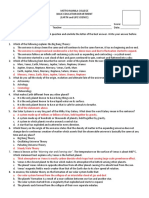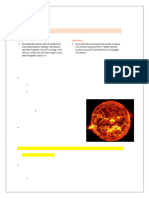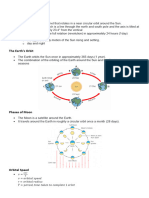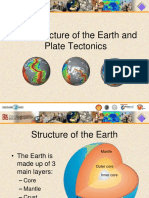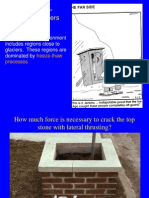0 ratings0% found this document useful (0 votes)
31 viewsConvection
Convection
Uploaded by
Tyler MroskoThis document discusses convection and magnetic fields. It explains that convection is the transfer of heat by the movement of fluids and is caused by density differences from temperature variations. Convection currents in Earth's mantle and outer core drive the planet's magnetic field. The magnetic field is generated by electric currents in the liquid outer core induced by the Earth's rotation. The magnetic field periodically reverses polarity over intervals of around 200,000 years.
Copyright:
© All Rights Reserved
Available Formats
Download as PPT, PDF, TXT or read online from Scribd
Convection
Convection
Uploaded by
Tyler Mrosko0 ratings0% found this document useful (0 votes)
31 views27 pagesThis document discusses convection and magnetic fields. It explains that convection is the transfer of heat by the movement of fluids and is caused by density differences from temperature variations. Convection currents in Earth's mantle and outer core drive the planet's magnetic field. The magnetic field is generated by electric currents in the liquid outer core induced by the Earth's rotation. The magnetic field periodically reverses polarity over intervals of around 200,000 years.
Original Description:
19
Original Title
19
Copyright
© © All Rights Reserved
Available Formats
PPT, PDF, TXT or read online from Scribd
Share this document
Did you find this document useful?
Is this content inappropriate?
This document discusses convection and magnetic fields. It explains that convection is the transfer of heat by the movement of fluids and is caused by density differences from temperature variations. Convection currents in Earth's mantle and outer core drive the planet's magnetic field. The magnetic field is generated by electric currents in the liquid outer core induced by the Earth's rotation. The magnetic field periodically reverses polarity over intervals of around 200,000 years.
Copyright:
© All Rights Reserved
Available Formats
Download as PPT, PDF, TXT or read online from Scribd
Download as ppt, pdf, or txt
0 ratings0% found this document useful (0 votes)
31 views27 pagesConvection
Convection
Uploaded by
Tyler MroskoThis document discusses convection and magnetic fields. It explains that convection is the transfer of heat by the movement of fluids and is caused by density differences from temperature variations. Convection currents in Earth's mantle and outer core drive the planet's magnetic field. The magnetic field is generated by electric currents in the liquid outer core induced by the Earth's rotation. The magnetic field periodically reverses polarity over intervals of around 200,000 years.
Copyright:
© All Rights Reserved
Available Formats
Download as PPT, PDF, TXT or read online from Scribd
Download as ppt, pdf, or txt
You are on page 1of 27
Convection
Convection: heat transfer not by
conduction or radiation.
Convection: heat transfer by the
movement of a heated fluid
Convection caused by differences of
temperature and density within a fluid.
Density - Mass per unit volume of a substance.
Results in simultanous transfer of heat and
matter
Convection Current
A constant flow begins as the cooler, denser
fluid continually sinks to the bottom helping
drive the warmer, lighter fluid upwards.
Convection Current is the flow that transfers
heat within a fluid,
Deferential heating and cooling of the fluid
which drive changes in the fluids density, and
the force of gravity combine to set convection
currents in motion
Weather is the result largely of convection
currents
Convection in the Mantle
Earths mantle being cooled at crust and heated
at outer core interface and within the mantle and
crust.
Gravity differences have to overcome the
viscosity of rocks in mantle
Convection currents particularly strong in the
weak Asthenosphere.
In mantle the viscosity is high enough that
convection currents flow at 10 cm/yr but hugh
areas can result in significant volume movement
If particle B sinks to B, its
temperature increases to TB,
which is still cooler and there-
fore more dense than the
surrounding mantle so it
continues to sink to the Core
Meanwhile, particle A from the hot
Interface with the Core (the
D layer) rises to A, it cools but
remains warmer less dense than
the surrounding, so it continues to
rise to the surface
Convection, Flow and Heat
Transfer in Core
Outer core liquid with low viscosity so
convection has little resistance
However outer core is iron which allows
easy conduction of heat so temperature
and related density differences do not
develop little convection
EXCEPT density difference caused by
differences in chemical composition
Inner core, solid iron, no convection
These would include:
Water vapor (H
2
O)
Sulfur dioxide (SO
2
)
Hydrogen sulfide (H
2
S)
Carbon dioxide (CO
2
)
Carbon Monoxide (CO)
Ammonia (NH
3
)
Methane (CH
4
)
The Evolving Atmosphere
Note that oxygen (O2) gas is not created by
volcanic eruptions
The Earth behaves as if there was a
magnet in its interior.
S
N
As a result a compass will always point
towards the North
S
N
A compass is a Magnetized
piece of metal that can spin.
S
N
N
S
The north tip of the compass
always points towards the
North MAGNETIC Pole of the
Earth
North attracts South
A Magnetic Field also protects us from
the Solar Wind
These particles are deflected by the
Earths Magnetic Field and basically
allow life to exist on the surface
unprotected
What causes a Planets Magnetic Field?
The Earths Magnetic Field is created in the
same way you make an electromagnet
In an electromagnet the electrons move
around an iron nail
+
-
The Iron Core of the Earth is an
electromagnet
The core is surrounded by
liquid Iron and Nickel
As electrons flow around the
core the magnetic field is
produced
The Earths rotation makes
the electrons flow at very
high speeds
The rotating Earth creates
movement of liquid iron in
Outer Core, inducing a magnetic
field, like in an electric motor
Cause and Result of Convection
in Earths Outer Core
Caused by rotation of Earth on Axis
Convection creates electric currents in the outer
liquid iron core which creates magnetic field.
Alignment with rotation subject to fluxuation
Periodically (250,000 years or so) reverses
polarity
Magnetic field protect Earth from Solar Wind
Other Planets in our Solar System have
Magnetic Fields
Planet
Magnetic Field
Mercury
100 times weaker than Earth
Venus
25,000 times weaker than Earth
Earth
30,000 60,000 nT
Mars
5000 times weaker than Earth
Jupiter
20,000 times greater than Earth
Saturn
540 times greater than Earth
Uranus
40 times greater than Earth
Neptune
that of Earth
Pluto
None that we know of
Mercury
Mercury has a weak magnetic field.
This suggests Mercury has an iron
core with liquid interior.
The weak magnetic field could be
the result of the slow rotation
period.
Venus
Venus appears to lack the
necessary ingredients to
generate a magnetic field
(no liquid core?)
Venus has a very weak magnetic field.
(About 100,000 times weaker than
Earths)
Venus also has very slow
rotation.
Mars
Mars also has a very weak magnetic
field.
(About 5,000 times weaker than Earths)
The interior of Mars appears to have
cooled so much that it is no longer
liquid.
The volcanoes in Mars are no longer active
There is no Earthquake activity on Mars
Jupiter
Jupiter has a strong magnetic field.
(About 20,000 times stronger than
Earths)
The Terrestrial planets generate
magnetic fields from iron at the
center.
But Jupiter has almost no iron core.
The magnetic field of Jupiter is produced by the motion of
liquefied metallic hydrogen found beneath the surface.
Saturn
Saturn also has a strong
magnetic field.
(About 540 times stronger
than Earths)
Saturns magnetic field is produced in the same way Jupiters is.
Uranus
The magnetic field in
Uranus is about 40 times
stronger than Earths
It is probably created in the
core of the planet, with ice,
rather than with iron.
Neptune
The magnetic field in Uranus
is about 1/4 times as strong
as Earths
It is probably created in the
same way as Uranus
Magnetic Field Reversal
Earths magnetic fluctuates in direction
and intensity
Caused by eddies in Outer Core
convection currents
Magnetic poles move around rotational
poles
Every 200,000 years over last 15 million
see full reversal of polarity
Takes 1-6000 years, strength diminishes
You might also like
- Grade 10 Science Summary From BookDocument3 pagesGrade 10 Science Summary From BookRyzhenSanchez-Infante85% (27)
- Practical Approach I, II, III, Toward Astrosphy Willi SucherDocument688 pagesPractical Approach I, II, III, Toward Astrosphy Willi SucherdusinkNo ratings yet
- PRAYER TO UNHOOK FROM SOLAR SYSTEM by Ian ClaytonDocument2 pagesPRAYER TO UNHOOK FROM SOLAR SYSTEM by Ian ClaytonChris100% (2)
- Quiz 1 Universe and The Solar System PDFDocument3 pagesQuiz 1 Universe and The Solar System PDFFrnc Sldd100% (1)
- 3b Magnetic FieldDocument46 pages3b Magnetic FieldPsycho GooseNo ratings yet
- Terrestrial Planets WebDocument38 pagesTerrestrial Planets WebHenry Zegarra RodriguezNo ratings yet
- Earth's MagnetismDocument2 pagesEarth's Magnetismjanandrei.delrosario100% (1)
- GEO 10-23 (Earth's Interior)Document10 pagesGEO 10-23 (Earth's Interior)AngelaNo ratings yet
- Section 1: Introduction: Formation of The Solar SystemDocument5 pagesSection 1: Introduction: Formation of The Solar SystemAkmal NizarNo ratings yet
- The Magic of Geophysics: Looking at The Interior of The Earth From The SurfaceDocument26 pagesThe Magic of Geophysics: Looking at The Interior of The Earth From The SurfaceJana Viegas de SousaNo ratings yet
- 6.2 Terrestrial PlanetsDocument64 pages6.2 Terrestrial PlanetsDonovan ZauggNo ratings yet
- Star TrekDocument22 pagesStar TrekShakira GayleNo ratings yet
- Big Bang TheoryDocument44 pagesBig Bang TheoryTyler MroskoNo ratings yet
- Bumi Dan Tata SuryaDocument41 pagesBumi Dan Tata SuryafereddyyNo ratings yet
- Plate TectonicsDocument55 pagesPlate TectonicsRenata AlvesNo ratings yet
- MagnetismDocument18 pagesMagnetismAnu BloodyKilla DarkSithaiNo ratings yet
- Earths InteriorDocument64 pagesEarths InteriorBuuye ChNo ratings yet
- Earthâ ™s Internal StructureDocument21 pagesEarthâ ™s Internal StructureSella Azelika OktavianiNo ratings yet
- Earth - Ts Internal StructureDocument21 pagesEarth - Ts Internal StructureEkala XuhalxNo ratings yet
- 2.1 - The Structure of The Earth and Plate TectonicsDocument52 pages2.1 - The Structure of The Earth and Plate TectonicsapolloquiverNo ratings yet
- EarthDocument40 pagesEarthfloppasupremacy45No ratings yet
- Role of RotationDocument32 pagesRole of RotationReynan FloresNo ratings yet
- Greenhouse EffectDocument19 pagesGreenhouse EffectNorman Honorio Aguila CelesteNo ratings yet
- Objective: Seismic Waves (P, S and Surface Waves) .: - Explore Properties ofDocument60 pagesObjective: Seismic Waves (P, S and Surface Waves) .: - Explore Properties ofnikki marbellaNo ratings yet
- 02 - S24 - Earth StructureDocument54 pages02 - S24 - Earth Structurehldp2001No ratings yet
- 19 SunDocument42 pages19 Sunphysicsolympiad22No ratings yet
- l3 Earth's Internal HeatDocument75 pagesl3 Earth's Internal HeatLearni J. EscoteNo ratings yet
- Ch-2. Earth's Magnetic Field DoneDocument60 pagesCh-2. Earth's Magnetic Field DoneKiran BNo ratings yet
- 2 Interior of The EarthDocument5 pages2 Interior of The EarthCHRISTIAN NATHANIEL PALMANo ratings yet
- 15 EarthinteriorDocument48 pages15 EarthinteriorJose Luric Nicolas MolobocoNo ratings yet
- GeographyDocument23 pagesGeographyIshu PurveNo ratings yet
- The Outer Core of The Earth Is A Liquid Layer About 2Document1 pageThe Outer Core of The Earth Is A Liquid Layer About 2Sharon TolentinoNo ratings yet
- ch+9Document41 pagesch+94k55fw9grfNo ratings yet
- The Formation of ElementsDocument30 pagesThe Formation of Elementsadityaraj8559No ratings yet
- Highlights of Astronomy - Norbert Bartel 7Document51 pagesHighlights of Astronomy - Norbert Bartel 7rocketReaderNo ratings yet
- CH 20Document62 pagesCH 20Ezzadin BabanNo ratings yet
- Notes - The Big Bang Theory, The Solar System, THE STRUCTURE OF THE EARTHDocument6 pagesNotes - The Big Bang Theory, The Solar System, THE STRUCTURE OF THE EARTHShravani KanojiaNo ratings yet
- 6.3 Outer PlanetsDocument44 pages6.3 Outer PlanetsDonovan ZauggNo ratings yet
- Formation of Planet Earth From A Soup ofDocument13 pagesFormation of Planet Earth From A Soup ofmd anisur hoqueNo ratings yet
- The Face of EarthDocument57 pagesThe Face of EarthEkala XuhalxNo ratings yet
- ISNS 4359 Earthquakes and Volcanoes (Aka Shake and Bake) : Lecture 4: Plate TectonicsDocument37 pagesISNS 4359 Earthquakes and Volcanoes (Aka Shake and Bake) : Lecture 4: Plate TectonicsAgeologistNo ratings yet
- Earth Structure Plate TectonicsDocument47 pagesEarth Structure Plate TectonicsAl Jawad100% (3)
- Interior Layers of The EarthDocument33 pagesInterior Layers of The EarthDIANNE GIGANTONENo ratings yet
- EarthDocument43 pagesEarthalutes2000No ratings yet
- 6.2. Stars and the Universe (Old version)Document27 pages6.2. Stars and the Universe (Old version)tajelliefNo ratings yet
- Space Physics NotesDocument5 pagesSpace Physics NotesjisungserbiaNo ratings yet
- 2-Earth Composition StructureDocument34 pages2-Earth Composition StructureDarsRayNo ratings yet
- Space PhysicsNotesDocument44 pagesSpace PhysicsNotesthethmusan.2007100% (1)
- 03 Earth and Life Science - EARTH - EARTH SUBSYTEMDocument84 pages03 Earth and Life Science - EARTH - EARTH SUBSYTEMCarlo Bryan Ramento100% (1)
- Lecture12 SolarSystem FormationDocument38 pagesLecture12 SolarSystem FormationRajni TyagiNo ratings yet
- Group 1Document15 pagesGroup 1Adefehinti AfolabiNo ratings yet
- 101 Class 18 Spring 2014Document66 pages101 Class 18 Spring 2014Tyler MroskoNo ratings yet
- 2-Earth_Composition_StructureDocument34 pages2-Earth_Composition_StructureKevin EderNo ratings yet
- The Structure of The Earth and Plate TectonicsDocument79 pagesThe Structure of The Earth and Plate TectonicsHyres Almerina AlturasNo ratings yet
- Giant Gas PlanetsDocument2 pagesGiant Gas PlanetsAron ValdiviaNo ratings yet
- 1B 2. Earth Spheres TectonicsDocument44 pages1B 2. Earth Spheres Tectonicsasauln9No ratings yet
- Topic03_RockCycle Earth Internal Structure_9b2f94c13d6fcd52cf1a2b8d64c8800aDocument24 pagesTopic03_RockCycle Earth Internal Structure_9b2f94c13d6fcd52cf1a2b8d64c8800aalialharrasi993No ratings yet
- Triangulation MethodDocument45 pagesTriangulation MethodBonifacio Guira JrNo ratings yet
- Solar_System_Formation (2)Document30 pagesSolar_System_Formation (2)floppasupremacy45No ratings yet
- Earth's MantleDocument31 pagesEarth's MantleJessica GoletaNo ratings yet
- Cosmic Explorers A Journey Through Our Solar System: DISCOVERY SERIESFrom EverandCosmic Explorers A Journey Through Our Solar System: DISCOVERY SERIESRating: 5 out of 5 stars5/5 (1)
- Groundwater Important Because It Is Where The Accessible Fresh Water Is !!!Document24 pagesGroundwater Important Because It Is Where The Accessible Fresh Water Is !!!Tyler MroskoNo ratings yet
- CH 20Document66 pagesCH 20Tyler MroskoNo ratings yet
- PP Per I Glacial 2014Document39 pagesPP Per I Glacial 2014Tyler MroskoNo ratings yet
- Glacial Geomorphology: - Ice Has Advanced and Retreated Across Continental Land Many Times Throughout Geologic HistoryDocument66 pagesGlacial Geomorphology: - Ice Has Advanced and Retreated Across Continental Land Many Times Throughout Geologic HistoryTyler MroskoNo ratings yet
- Life On Earth Is A Constant Battle Between The Tectonic Forces That Want To Make The Earth LUMPY and The Geomorphic Agents That Want To Make The Earth SMOOTHDocument37 pagesLife On Earth Is A Constant Battle Between The Tectonic Forces That Want To Make The Earth LUMPY and The Geomorphic Agents That Want To Make The Earth SMOOTHTyler MroskoNo ratings yet
- Big Bang TheoryDocument44 pagesBig Bang TheoryTyler MroskoNo ratings yet
- Paleomagnetism: Curie PointDocument47 pagesPaleomagnetism: Curie PointTyler MroskoNo ratings yet
- Geology 101 Class 9 Spring 2014Document51 pagesGeology 101 Class 9 Spring 2014Tyler MroskoNo ratings yet
- Geology 101 X Class 12 Spring 2014Document58 pagesGeology 101 X Class 12 Spring 2014Tyler MroskoNo ratings yet
- How Waves Are DescribedDocument19 pagesHow Waves Are DescribedTyler Mrosko100% (1)
- Physiology of Solid' Earth - Driving Mechanism For Plate TectonicsDocument8 pagesPhysiology of Solid' Earth - Driving Mechanism For Plate TectonicsTyler MroskoNo ratings yet
- Geology 101 Class 21-22 Spring 2014Document78 pagesGeology 101 Class 21-22 Spring 2014Tyler MroskoNo ratings yet
- 101 Class 18 Spring 2014Document66 pages101 Class 18 Spring 2014Tyler MroskoNo ratings yet
- 101 Spring 2014 Lecture 16 ActualDocument27 pages101 Spring 2014 Lecture 16 ActualTyler MroskoNo ratings yet
- Class 5Document94 pagesClass 5Tyler MroskoNo ratings yet
- Class 8Document30 pagesClass 8Tyler MroskoNo ratings yet
- Scientific Method - GeologyDocument119 pagesScientific Method - GeologyTyler MroskoNo ratings yet
- Geology 101 Class 11 SPRING 2014: Question of The Day - Do Otters Contribute To Sedimentary Rock Formation?Document80 pagesGeology 101 Class 11 SPRING 2014: Question of The Day - Do Otters Contribute To Sedimentary Rock Formation?Tyler MroskoNo ratings yet
- Class 10Document26 pagesClass 10Tyler MroskoNo ratings yet
- Class 7Document36 pagesClass 7Tyler MroskoNo ratings yet
- Pete 311 Lab 11 MemoDocument3 pagesPete 311 Lab 11 MemoTyler MroskoNo ratings yet
- GEOLOGY 101 Sections 519-527 Spring 2014 Class 3Document44 pagesGEOLOGY 101 Sections 519-527 Spring 2014 Class 3Tyler MroskoNo ratings yet
- Class 4Document56 pagesClass 4Tyler MroskoNo ratings yet
- Lab Report 1: Core Dimensions, Liquid Density, and Acid TestDocument2 pagesLab Report 1: Core Dimensions, Liquid Density, and Acid TestTyler MroskoNo ratings yet
- PETE 311 Lab 7 MemoDocument4 pagesPETE 311 Lab 7 MemoTyler MroskoNo ratings yet
- Pete 311 Lab 12 MemoDocument2 pagesPete 311 Lab 12 MemoTyler MroskoNo ratings yet
- Class 2Document33 pagesClass 2Tyler MroskoNo ratings yet
- PETE 311 Lab 9 MemoDocument2 pagesPETE 311 Lab 9 MemoTyler MroskoNo ratings yet
- Pete 311 Lab 10 MemoDocument2 pagesPete 311 Lab 10 MemoTyler MroskoNo ratings yet
- Notebook Lesson PowerPoint TemplatesDocument56 pagesNotebook Lesson PowerPoint TemplatesBernadette FalcesoNo ratings yet
- Love Marriage KP AstrologyDocument2 pagesLove Marriage KP AstrologyRakeshVadekar100% (2)
- Venusin Traits of Natal Chart-A Crucial PointDocument42 pagesVenusin Traits of Natal Chart-A Crucial Pointfarzana25100% (1)
- High End Cars DealershipDocument40 pagesHigh End Cars DealershipNovi SasmitaNo ratings yet
- Shashank Tiwar - KP Astrology SoftwareDocument3 pagesShashank Tiwar - KP Astrology Softwareoccultist95No ratings yet
- Makalah Bayi Prematur BoluuDocument32 pagesMakalah Bayi Prematur BoluuRENISA AMALIA TAHIRNo ratings yet
- Watercolor Portfolio For Students by SlidesgoDocument51 pagesWatercolor Portfolio For Students by Slidesgoannsopihe girandoNo ratings yet
- Poem-Planet Roll CallDocument4 pagesPoem-Planet Roll Callnadia100% (1)
- Our Solar System: A Write On ActivityDocument19 pagesOur Solar System: A Write On ActivityZinelabedine OulimeNo ratings yet
- Science Reviewer For Gr.3Document43 pagesScience Reviewer For Gr.3ARISTHEA C. LABRADORNo ratings yet
- Cold Planet StoryDocument5 pagesCold Planet StoryОльга АндрющенкоNo ratings yet
- Vitamin D Deficiency Clinical Case by SlidesgoDocument58 pagesVitamin D Deficiency Clinical Case by Slidesgoaldizab.miNo ratings yet
- Monday Tuesday Wednesday Thursday Friday: GRADES 1 To 12 Daily Lesson LogDocument6 pagesMonday Tuesday Wednesday Thursday Friday: GRADES 1 To 12 Daily Lesson LogRonald Tiongson Parana Jr.No ratings yet
- Malaysi A: Silvia Estevania XII IPSDocument34 pagesMalaysi A: Silvia Estevania XII IPSSilvia EstevaniaNo ratings yet
- Engineering Technology & Drafting Major For College - Industrial Production Technologies by SlidesgoDocument55 pagesEngineering Technology & Drafting Major For College - Industrial Production Technologies by Slidesgorayfan DewantaraNo ratings yet
- Most Famous Murder Cases - Thesis Defense by SlidesgoDocument51 pagesMost Famous Murder Cases - Thesis Defense by SlidesgoEltun JalilliNo ratings yet
- Elegant Education Pack For Students XL by SlidesgoDocument129 pagesElegant Education Pack For Students XL by SlidesgoThuỳ LinhNo ratings yet
- International Civil Aviation Day by SlidesgoDocument57 pagesInternational Civil Aviation Day by Slidesgomakichu12No ratings yet
- Lesson 1 Introduction To EntrepreneurshipDocument71 pagesLesson 1 Introduction To EntrepreneurshipZien ShionNo ratings yet
- Network Security Introduction WorkshopDocument58 pagesNetwork Security Introduction WorkshopsanagenANJNo ratings yet
- Cj51 Public PartDocument5 pagesCj51 Public PartbarryhopewellNo ratings yet
- Aquatic and Physical Therapy Center XL by SlidesgoDocument92 pagesAquatic and Physical Therapy Center XL by SlidesgoKiki IstratkovaNo ratings yet
- Acceptable MethodsDocument57 pagesAcceptable MethodsJulia Grace PastoleroNo ratings yet
- By Mrs. Y Satyamma Bharadwaj, India: Timing of New JobDocument7 pagesBy Mrs. Y Satyamma Bharadwaj, India: Timing of New JobMurli Padbidri50% (2)
- Healthy Food Phone App Pitch DeckDocument60 pagesHealthy Food Phone App Pitch DeckMichelle BalaoingNo ratings yet
- Life in The Outer Solar SystemDocument13 pagesLife in The Outer Solar Systemkn9965041No ratings yet
- Ehlers-Danlos Syndrome Clinical Case by SlidesgoDocument58 pagesEhlers-Danlos Syndrome Clinical Case by SlidesgoIcha AzizahNo ratings yet



